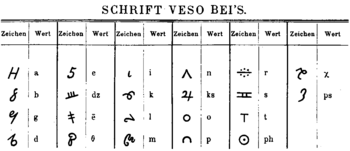Gjirokastër alphabet

Veso Bey script
The Gjirokastër alphabet also known as Veso Bey alphabet is one of the original Albanian language alphabets of 19th century.[1] It is named after the town of Gjirokastër in South Albania where it was first encountered by the the scholar Johann Georg von Hahn, also after Veso bey, a rich local bey from the influential Alizoti family who provided it to Hahn. Hahn published in 1854 in his "Albanesische Studien", in Jena.[2]
History
According to Hahn, the alphabet was given to him by Veso bey, and had been used that far within Alizoti family circles.[2]
"Finally, another alphabet from southern Albania must be recorded here, one which the present author owes the discovery of to Veso bey, who is one of the most prominent chiefs of Gjirokastër, from the family of the Alisot Pashalides. Veso Bey learned it in his youth from an Albanian hodja as a secret script which his family inherited, and used it himself for correspondence with his relatives.
Script
The alphabet, probably cryptic,[3] contains 22 letters.[4]
See also
Reference
- ↑ Münchner Zeitschrift für Balkankunde (in German). 4. München: R. Trofenik. 1984. p. 204. ISSN 0170-8929. OCLC 5784326.
- 1 2 The Elbasan Gospel Manuscript (Anonimi i Elbasanit), 1761, and the struggle for an original Albanian alphabet by Robert Elsie
- ↑ David Diringer; Reinhold Regensburger (1968). The alphabet: a key to the history of mankind. Hutchinson. p. 284.
- ↑ Old Albanian Scripts
This article is issued from
Wikipedia.
The text is licensed under Creative Commons - Attribution - Sharealike.
Additional terms may apply for the media files.